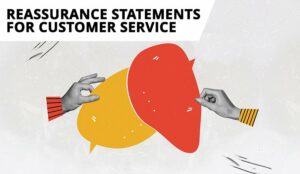We share a tried-and-tested method of delivering bad news to a customer.
This approach was originally outlined in Customer Service Expert Gavin Scott’s book: “Finding Gold Dust: How to Create Exceptional Customer Experiences“.
Step 1: Acknowledge What’s Happening and Demonstrate That You’ve Been Listening
Acknowledging the customer’s problem and how it impacts them is key. Without doing so, you cannot properly reassure them that everything will be okay; nor can you demonstrate that you have been listening.
Too often when a customer phones in with a query and the advisor has to deliver bad news, they do so and then they jump straight into talking about what they can do for the customer instead.
Take a step back and let the customer react. Then listen to what they have said and address any concerns…
A better approach when you give bad news is to first take a step back and let them react. Then listen to what they have said and address any concerns by repeating them back and using an appropriate acknowledgement statement, such as:
- “I can absolutely see the issues that we’ve got here.”
- “I’m sorry you are having this problem.”
- “I can see how this has been frustrating for you.”
By making a statement like this, the advisor conveys to the customer that they understand the problem. This helps to ensure that everyone is on the same page and is a useful technique in establishing rapport.
Find lots more great acknowledgement statements in our article: The Top 12 Acknowledgement Statements for Customer Service
Step 2: Empathize With the Customer by Focusing on What They’ve Told You
After acknowledging the customer, we use empathy so that the customer feels as though the advisor understands how they are feeling.
Pick up on the emotions that the customer expresses. If they say that they are disappointed, the advisor can use that to say something like:
- “I can understand why you are feeling disappointed.”
- “If I were in you’re position, I think that I would be disappointed.”
- “I can tell that you are disappointed. This is certainly a tricky situation.”
Empathy is all about taking that imaginative leap into the customer’s shoes. If you can do that, these statements will sound genuine, authentic and will work wonders in terms of building rapport.
As Chloe, one of our readers, says: “Empathy is your best friend. Take responsibility for the call, use ‘I’ instead of ‘We’ and show that you are actively listening and that you truly do care about your callers.”
# Tip – Remember to avoid: “I’m sorry that you feel disappointed.” That is not walking in the customer’s shoes. It is fake empathy.
For more statements like those included in the bullet points above, read our article: 18 Empathy Statements That Help Improve Customer-Agent Rapport
Step 3: Advocate for the Customer. Tell Them What You’re Going to Do
Tell the customer what you’re going to do to make sure that this situation doesn’t happen again for anyone else.
The advisor can appear to be championing their cause within the business…
This is an important step as it shows the customer that the advisor is on their side. The advisor can appear to be championing their cause within the business.
Yet advisors often miss this step because they feel as though they are powerless and that there is nothing that they can do to stop this situation from happening again.
There is, however, always something that they can do. For example, the advisor could:
- Give feedback to the powers that be
- Pass this information on to their line manager
- Share this information with the relevant department
The advisor can then say: “If I give them this feedback and there is a clear trend that this is a widespread problem, we can do something about it – in terms of an amendment to a process.”
In addition, the advisor may also want to highlight that, by passing on the customer’s feedback, they can help to make sure that this problem doesn’t impact other customers in the future.
Step 4: Tell the Customer What You Can Do for Them at That Moment
You’ve acknowledged the situation, empathized with the customer and you have now advocated for them. By this point, you will likely have built up enough rapport to move on to your alternative solution.
To do this, you can simply say: “What I can do for you today is this…” and move the conversation along.

A key mistake in delivering bad news is that the advisor jumps straight to this step, missing out the other three.
A key mistake in delivering bad news is that the advisor jumps straight to this step, missing out the other three.
When they do this and fail to build rapport beforehand, the customer is much more likely to push back and fixate on the bad news.
This is such a common mistake that leads to long call handling times. So, let’s come back to this after the great example below of how to deliver bad news.
Find out other methods for reducing call handling times in our article: 49 Tips for Reducing Average Handling Time (AHT)
These Steps Can Flow Into One Powerful Statement…
“I can absolutely see the issues that we’ve got here and I can definitely sense your frustration. I know this hasn’t been easy for you.
I’ll make sure that we feed this back to the relevant department so that it doesn’t happen to anyone else in the future. What I can do for you today is this…”
As you can see, each of our four steps has been followed here:
- Step 1 – I can absolutely see the issues that we’ve got here.
- Step 2 – I can definitely sense your frustration, I know this hasn’t been easy for you.
- Step 3 – I’ll make sure that we feed this back to the relevant department so that it doesn’t happen to anyone else in the future.
- Step 4 – What I can do for you today is this…
Just Avoid Jumping Straight to Step 4
To best deliver bad news to a customer, you demonstrate some empathy, advocate for the customer and then tell them what you can do.
However, what most people do is jump straight to Step 4 and start the conversation with a negative word like: “Unfortunately…”.
Not only is this a bad practice, but it is a terrible example of how to frame your language in the contact centre.

Gavin Scott
“The words you use can massively impact the outcomes that you get. You need to make sure you’re focusing on using positive language rather than negative language,” says Gavin.
“Focus on what you can do for the customer at that time. Avoid negative phrases in your interactions with customers and follow my four steps for delivering bad news.”
Remember, your goal is to make conversations feel easy for customers. It is important to demonstrate that you value their time.
And Avoid These Bad Phrases When Delivering Bad News
“Unfortunately” is just one of many negative words and phrases that advisors too often use to deliver bad news to customers. Other common examples include:
- “I’m afraid”
- “I’m sad to say”
- “Bear with me”
Using these words is so much worse that taking our four-step approach. Just consider the two statements below.
Statement 1 – Starts with unfortunately
“Unfortunately, we don’t have any size tens in that dress in stock.”
Statement 2 – Follows the Four-Step Approach
“That’s a lovely dress and I know you’ve tried it on and it looks great. I don’t have any size tens right now but I can get some of these in stock for you by Tuesday. In fact, if you want, I can get it delivered directly to your home address.
Would that be an option you’d be interested in? I recognize that you’re not going to be able to walk away with it today and wear it tonight, but in just two days it can be at your doorstep.”
As Gavin says: “One of those approaches is going to make a customer connect with your business and the other is going to make them disconnect from your business.”
A Final Bad Mistake to Avoid
When delivering bad news, advisors sometimes feel that the justification of “It’s company policy” or “That’s the process” is good enough to satisfy the customer. This just isn’t the case.
Instead, when it is the fault of the process or procedure, nicely explain to the customer why that process is in place.
Rather than saying “That’s the process we need to follow…”, it is better to say “To protect you, what we do is this…” or “To make sure that we adhere to government regulations, what we do is this…”
The customer is now much more likely to understand that the organization’s process is in place for their benefit.
For more terrible examples of common contact centre phrases to avoid, read our article: 15 Things a Call Centre Agent Should Never Say (But Many Do)
To discover more advice on how to deliver bad news to customers, read these articles next:
- How to Deliver Bad News in Customer Service
- 21 Ways to Say “I’m Sorry” and Apologize to a Customer for Bad Service
- 7 Examples of Bad Customer Service and How to Fix Them
Author: Robyn Coppell
Reviewed by: Hannah Swankie
Published On: 3rd Mar 2021 - Last modified: 21st May 2024
Read more about - Customer Service Strategy, Call Handling, Editor's Picks, Gavin Scott
















